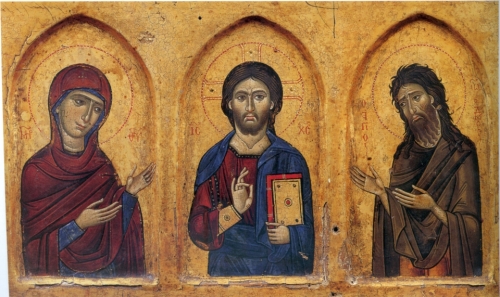Perhaps the second most portrayed person in iconography is St. John the Baptist or, as he is called in the East, St. John the Forerunner. John is important to Christianity because of his role in announcing the coming of the Messiah. John first announced Jesus in his mother’s womb at the Visitation, announced his coming to the children of Israel, preached a baptism of repentance, baptized Jesus, pointed Jesus out to the first of the Apostles (Jn 1), and was eventually arrested and put to death for criticizing King Herod. His entire life is such a testament to Jesus Christ that when his followers complain to him that Jesus was gaining more followers than John, John responded to them saying, “He must increase, but I must decrease” (Jn 3:30).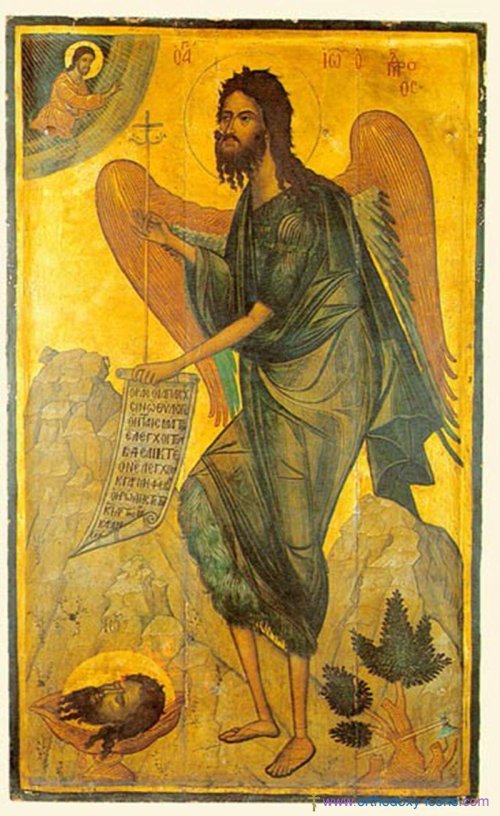
John is given a very recognizable form in iconography. He is portrayed with long wild hair and an unkempt beard because John was a nazirite and wandered for years in the desert. He is usually dressed in wild animal skins, which corresponds to the Gospel accounts. In some icons John may have a green robe, which symbolizes earthliness and his wandering in the desert.
In a type of icon called a Deisis, we see St. John the Baptist and the Blessed Virgin Mary on each side of Jesus offering prayer. In these depictions John is richly robed, serene, and reverent, making him beautiful to look upon. His head is inclined toward Christ, showing humility and his hands are extended to Christ in supplication. John here represents a “bridge” between the Christ and the Old Testament, himself being the last and greatest of the Old Testament prophets. Mary, on the other side, serves as a “bridge” between Christ and the New Testament, herself being the first Christian. Both offer their prayers to Christ.
John is often portrayed with wings in singular portraits (see above). This is not to say that John was secretly an angel, but to signify John’s office as herald and minister to Christ. The Greek word for messenger, “angelos,” can also mean angel. John’s purpose was to be a herald:
“Behold, I send my messenger before your face,
who will prepare your way before you.
The voice of one crying in the wilderness:
Prepare the way of the Lord:
Make his paths straight.”
– Mk 1:2-3
John’s right hand is sometimes giving a blessing, in others it is pointing to what is in his left hand. John is usually shown holding one or more of four things in his left hand:
John is almost always shown carrying a staff with a cross on top. This shows his authority as messenger and the cross announces both the coming and death of Christ.
A Scroll
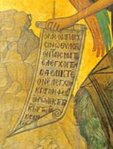 In icons, the way in which a subject communicates a message to the viewer is by way of a scroll or book. In the icons of John, the message is usually in Greek and normally comes from, or sums up, John’s preaching. Some examples include, “Come Ye to Christ with Faith and Be Saved,” “I saw and witnessed concerning him, ‘Behold the Lamb of God who takes away the sins of the world,” and “Repent, for the Kingdom of Heaven is come near” among others.
In icons, the way in which a subject communicates a message to the viewer is by way of a scroll or book. In the icons of John, the message is usually in Greek and normally comes from, or sums up, John’s preaching. Some examples include, “Come Ye to Christ with Faith and Be Saved,” “I saw and witnessed concerning him, ‘Behold the Lamb of God who takes away the sins of the world,” and “Repent, for the Kingdom of Heaven is come near” among others.
A Dish with an Infant
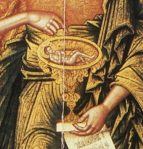 John is often shown holding a dish containing a child at whom he points. This is the infant Christ, whom John first recognized while both were in the womb. This was his first act of preparing the way for the Messiah, so it is appropriate that this would be part of his iconography. The dish is used in the Divine Liturgy and is called a “diskos” (dish), which holds the Eucharist. The message is clear: come to Christ in the Eucharist.
John is often shown holding a dish containing a child at whom he points. This is the infant Christ, whom John first recognized while both were in the womb. This was his first act of preparing the way for the Messiah, so it is appropriate that this would be part of his iconography. The dish is used in the Divine Liturgy and is called a “diskos” (dish), which holds the Eucharist. The message is clear: come to Christ in the Eucharist.
A Chalice with His Head
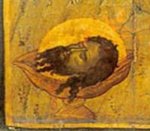 This is perhaps my favorite object that John carries. John is often shown carrying his head in a dish. John was of course martyred by beheading. In iconography (and in Christian art in general) a martyr often carries a sign of his martyrdom, whether it be the instrument that did it, or certain marks, or (in this case) his or her own head. John is usually shown with two heads: one in his hands or his feet, the other still firmly attached.
This is perhaps my favorite object that John carries. John is often shown carrying his head in a dish. John was of course martyred by beheading. In iconography (and in Christian art in general) a martyr often carries a sign of his martyrdom, whether it be the instrument that did it, or certain marks, or (in this case) his or her own head. John is usually shown with two heads: one in his hands or his feet, the other still firmly attached.
In some icons, John looks toward Christ, who is shown in a corner of the icon surrounded by a mandorla. In other icons, a simple mandorla, or a hand of God, can be found, showing divine blessing for the mission of John.
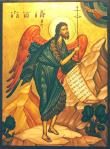
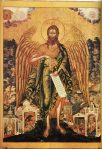 John’s setting is usually in the midst of the desert or wilderness. This setting can be portrayed in several ways. In some icons (such as the one to the right), John is in the midst of a very mountainous, stony territory, where all that grows are scraggly shrubs. In other icons (such as the one to the left), John is in the midst of a forest. This is a way of interpreting the word “wilderness,” which does not necessarily denote a desert but rather “the boonies” or the places where no one else live, which can be a forest. In some icons, you will see a river. This is the River Jordhttps://slaveoftheimmaculate.wordpress.com/wp-admin/post.php?post=475&action=edit&message=10an, where John spent his ministry baptizing.
John’s setting is usually in the midst of the desert or wilderness. This setting can be portrayed in several ways. In some icons (such as the one to the right), John is in the midst of a very mountainous, stony territory, where all that grows are scraggly shrubs. In other icons (such as the one to the left), John is in the midst of a forest. This is a way of interpreting the word “wilderness,” which does not necessarily denote a desert but rather “the boonies” or the places where no one else live, which can be a forest. In some icons, you will see a river. This is the River Jordhttps://slaveoftheimmaculate.wordpress.com/wp-admin/post.php?post=475&action=edit&message=10an, where John spent his ministry baptizing.
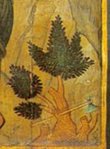 In many icons of St. John the Baptist, there is often a shrub with an axe at its roots. This calls to mind John’s warning that,
In many icons of St. John the Baptist, there is often a shrub with an axe at its roots. This calls to mind John’s warning that,
“Even now the axe is laid to the root of the trees; every tree therefore that does not bear good fruit is cut down and thrown into the fire.” (Lk 3:9)
All of this serves to remind us of John’s preaching. We see especially that John’s preaching will never be done until Christ’s glorious Second Coming. John continues the prepare hearts and minds for Christ and his icons are one of the ways in which he does it. In an icon, the subject is mystically present to us. So all of the signs of his preaching and martyrdom are not things of the past meant for others but are messages direct to us. We are to heed his preaching and prepare our hearts for the coming of the Messiah. This is why John is so vitally important to the season of Advent as we prepare our hearts for the coming of the Messiah. His message, however is for all times and places. Let us heed his message and seek the Lamb of God whom he proclaimed!
For a list of all posts on iconography, please click here.
To see more icons of John the Baptist, click the gallery below.

